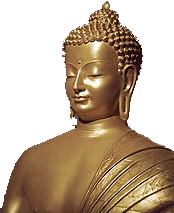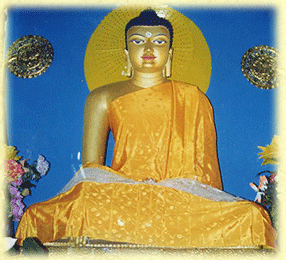|
India was the home of Buddhism, but today it is practiced only on the margins of the sub-continent in
Leh, Ladakh, Nepal, Bhutan and Sri Lanka. There are approximately 5 million Buddhists in India, while some of the Buddhists have been recent converted ones, the last adherents of the early schools of Buddhism having been killed or converted by the Muslim invaders of the 13th century. However, the home of what became one of the Asia’s major religions is now mainly the setting for the extraordinarily beautiful artistic and architectural remnants of what was for several centuries the region’s dominant religion.
There are some famous pilgrimage sites which are of great significance for Buddhists in India. Mainly, there are four places which are associated with the Buddha and his followers should also visit. |
 |
|
These
four places are the Lumbini, the
Buddha’s birthplace, Bodhgaya, where
he attained “supreme enlightenment”,
the deer park at Sarnath, where he
preached his first sermon and set in
motion the Wheel of Law, and
Kushinagara, where he died at the age
of 80. Besides this, there are some of the remarkable monuments, sculptures and works of art in Sanchi and
Ajanta, where it is still possible to see the Buddhist culture flowering in India. |
|
|
|
 |
The
Buddha’s life
Siddharta Gautama, who was
also later known as the
Buddha, the Enlightened One
was born as a prince into the
warrior caste in about 563
B.C. Prince Gautama was roused
to profound inquiry into the
existing beliefs and practices
of the Hindu faith. He was a
sensitive young man, and felt
the cruelty of life, of
sickness, old age and death
assailing the people. He
married at the age of 16 and
also had a son. He sought to
fathom the depths of human
experience. In his despair of
not finding any solution when
he reached the age of 29 he
left home and wandered as a
beggar and ascetic. About six
years later he spent some time
in Bodhgaya and while sitting
under the Bodhi tree,
meditating, one day he was
tempted by the demon Mara,
with all the desires of the
world. Resisting these
temptations, he received
enlightenment and was known as
the Buddha, the Enlightened
one. |
|
Later
he preached his first sermon
on “the Foundation of
Righteousness” in the deer
park in Sarnath. These scenes
were the common motifs of
Buddhist art. He said that the
pain is the core of life and
there is no escape from
suffering in the birth and
rebirth to which all beings
are committed. Only the moral
path of right thought and
right deed could relieve the
human sorrows. The Buddha did
not speculate about God, but
considered that the salvation
from the rigors of this world
lies in the attainment of
Nirvana or freedom from the
cycle of birth and death. Many
feudal princes and various
people listened to the message
of the Buddha and found solace
in his teachings. By the time
he died, he had established a
small band of monks and nuns
known as the Sangha, and had
followers across all over
north India. His body was
cremated, and the ashes,
regarded as precious relics,
were divided up among the
people to whom he had
preached. Some have been
discovered in Peshawar and at
Piprawa, close to his
birthplace. |
|
From the Buddha’s death to the destruction of Nalanda in 1197 AD, Buddhism went through three phases in India. These phases are Hinayana, Mahayana and Vajrayana. Though these phases were not mutually exclusive, but where followed simultaneously in different regions. The Hinayana, or Little Way insisted on the monastic way of life as the only path to achieve nirvana. Divided into many schools, the only surviving Hinayana tradition is the Theravada Buddhism, which was taken to Sri Lanka by the Emperor Ashoka’s son Mahinda where it became the state religion under King Dutthagamini in the 1st century A.D. The followers of the Mahayana or the Great Way believed in the possibility of salvation of all. They practiced a more devotional form of meditation, and new figures came to play a prominent part in their beliefs and their worship or the Bodhisattvas. These were the saint who were predestined to reach the state of enlightenment through thousands of rebirths. They aspired to Buddhahood, however, not for their own sake but for the sake of all living things. The Buddha is believed to have passed through numerous existences in preparation for his final mission. One of the most notable Mahayana philosophers was the 2nd or 3rd century saint, Nagarjuna. Mahayana Buddhism became dominant over most of South Asia, and its influence can be seen in various Buddhist arts in India.
Buddhist Beliefs
Buddhism is based on the Buddha’s own preaching. He developed his beliefs in reaction to the Brahmanism of his time, rejecting several of the doctrines of Vedic religion which were widely held in his lifetime, likely the Vedic gods, scriptures and priesthood, and all social distinctions based on caste. However, he did not believe in the cyclical nature of life and the nature of an individual’s existence is determined by a natural process of reward and punishment for deeds in previous lives. According to the Buddha, there is no eternal soul. The Buddha preached four Noble truths. These truths are that the life is painful, suffering is caused by ignorance and desire, and beyond the suffering of life there is a state which cannot be described and also known as nirvana and that nirvana can be reached by following an eightfold path. The essential elements of the eightfold path are the perfection of Wisdom, morality and meditation. Following the Buddha’s death a succession of council was called to try and reach agreement on doctrine. The first three were held within 140 years of the Buddha’s death, the fourth being held at Pataliputra (modern Patna) during the reign of the Emperor Ashoka, who also get converted to Buddhism. Under his reign Buddhism spread throughout South Asia and opened the routes through North West India for Buddhism to travel into China, where it had become a force by the 1st century AD.
There was a gradual decline of Buddhism in India due to the growing similarity in the practice of Hinduism and Buddhism. Mahayana Buddhism, with its reverence of Bodhisattvas and its devotional character, was very difficult to distinguish from the Hinduism in the several parts of North India from the 7th to the 12th centuries AD. The Muslim conquest and the large scale slaughter of monks and the destruction of monasteries further resulted in the decline of Buddhism. |

